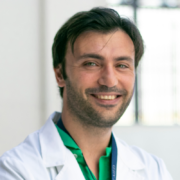
Cenni biografici
After graduating MSc with “summa cum laude” in 2007, I was awarded a scholarship by University of Palermo to undertake 6-months research in Prof. Hideaki Nagase’s laboratory at the Kennedy Institute of Rheumatology (Imperial College London). I quickly got involved with the research field and obtained valuable data. As result, I was awarded a scholarship from the Kennedy Institute Trustee to undertake a PhD and continuing my project. During my PhD studies I discovered that the endocytic receptor low-density lipoprotein receptor-related protein-1 (LRP-1) and its shed form play a crucial role in regulating TIMP-3 levels in the tissue. In addition, I found that TIMP-3 is also able to regulate extracellular levels of metalloproteinases by bridging their binding to LRP-1. This project was carried out in collaboration with Prof. Gillian Murphy at Cancer Research UK (Cambridge Institute). These results prompted me to apply for a post-doctoral fellowship from the Japan Society for the Promotion of Science with a project aimed to generate a tool for increasing levels of TIMP-3 in the tissue. TIMP-3 has been shown to have a protective role in a number of diseases, including cancer, osteoarthritis and atherosclerosis. This tool, that I named TIMP3-TRAP, may potentially have therapeutical applications in such diseases. Therefore, after a brief post-doc appointment at the University of Oxford to complete my studies, I moved to Prof Kadomatsu’s laboratory at Nagoya University (Japan) where I generated the TIMP3-TRAP and I have successfully tested it in a number of biological processes involving TIMP-3, including metalloproteinase-based shedding of transmembrane proteins. Results that I accomplished in both labs have been published in prestigious scientific journals (including Matrix Biology i.f. 11.58) and presented at several international conferences (e.g. Best Oral Presentation at the IPS Meeting at Keble College, Oxford, 2016).
After my postdoctoral training at Nagoya University, I planned to enlarge my expertise by learning cutting-edge technologies in proteomics and methods to generate transgenic mice. To pursue my objective, I applied and I was awarded the Technical University of Munich (TUM) Foundation start-up fellowship to join Prof. Lichtenthaler’s group in the neuroproteomics department of the DZNE Munich (Germany), and, to further support my postdoctoral training, I applied and was awarded the Marie Skłodowska-Curie fellowship from the European Commission. At the DZNE Munich, I used shotgun quantitative proteomics to identify novel therapeutic targets in neurodegenerative diseases, including Alzheimer’s. By using an array of forefront technologies in proteomics, single-cell RNA sequencing and in vivo models, I identified a pro-inflammatory protein, iRhom2, as a crucial player in neuroinflammation and in the progression of Alzheimer’s disease (AD), which represents a novel attractive target for drug development in AD. My study was chosen by the European Commission (EC) as one of the most promising and impactful EU-funded projects and, as such, presented to the media, policy-makers and industry (“Control of the iRhom2 protein may hold the key to preventing Alzheimer’s disease”, article by Alan Hodgson, EU CORDIS writer).
Attività Scientifica
In 2019, I started my own lab at Fondazione Ri.MED. Other than carrying out research on ADAMs, especially ADAM17, its endogenous inhibitor TIMP-3 and its essential cofactors iRhom1 and iRhom2, while at Ri.MED I have established a Proteomics Core Facility to support my studies and the forefront scientific research of the institute. The Proteomics Core Facility is becoming a benchmark for the scientific research not only in the area, but also in Italy and overseas. This is proven by a number of high-impact studies and grant applications in which I have been involved as a collaborator.
